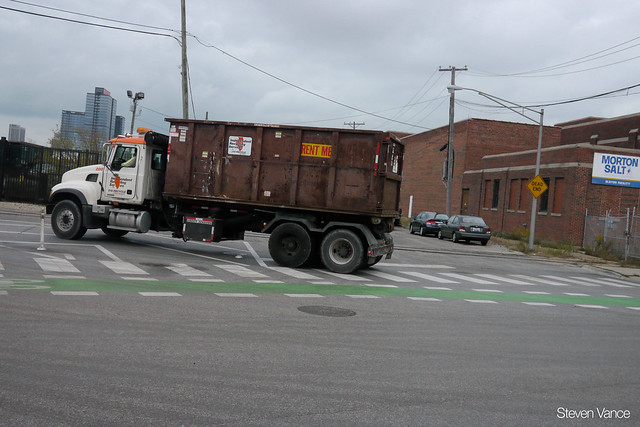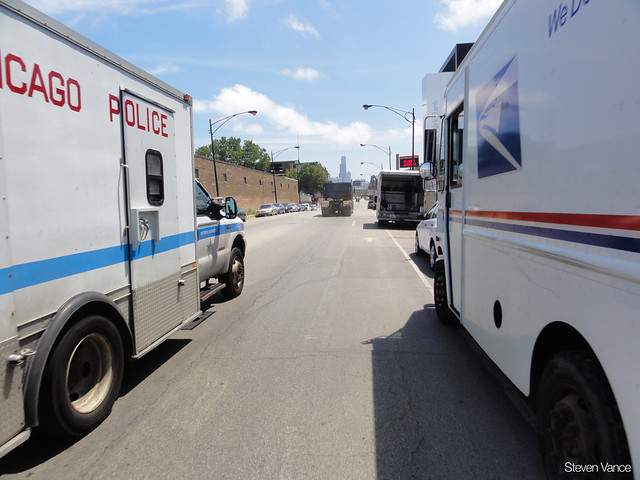To reach Mayor Rahm Emanuel's goal of having five percent of trips under five miles made by bike, bicycling will have to appeal to a much broader base of people than it does today. CDOT's bikeway projects will only succeed at that goal if new cyclists feel safe and comfortable while riding in these lanes -- which, in turn, largely depends on whether they feel safe from nearby traffic.
Elston Avenue, where a proposal for buffered bike lanes has proven contentious, is a good place to measure how fast people are driving -- and whether bike lanes provide sufficient separation from speeding cars. CDOT has proposed a buffered bike lane from North Avenue to Webster Avenue, and, at some point in the future, an extension further north through Avondale and beyond. The North Branch Works business association isn't pleased with the proposal, saying that it will impede truck traffic.
John Greenfield and I spent last Tuesday morning measuring drivers’ speeds at two different locations on Elston. We used our new radar speed gun -- donated by Streetsblog readers -- to collect data on northbound drivers on Elston at Blackhawk/Magnolia, where Elston bends slightly, and on Elston at Willow, next to the Creative Scholars Preschool. The Blackhawk/Magnolia intersection is part of the stretch of Elston that has a bike lane separated from traffic by flexible posts, and the Willow intersection is part of CDOT's new project area.
The proportion of speeders was high at both locations. At Blackhawk/Magnolia, 37.6 percent of drivers exceeded the 30 mph speed limit, and at Willow, 32.3 percent of drivers were speeding. We measured vehicle speeds for 15 minutes at each location, capturing 100 drivers apiece. While ideally a larger sample would be collected to gauge the extent of speeding, our measurements suggest there is a higher proportion of speeders on Elston than on other bike routes known for high speeds, like Marshall Boulevard and 55th Street.
High motor vehicle speeds not only pose a danger to people who bike, they also discourage people from biking in the first place by increasing the perception of risk. Likewise, bikeways that provide greater separation from speeding traffic not only reduce the risk of injury, they also lead more people to bike by increasing the perception of safety. To compensate for the high level of speeding on Elston -- and the preponderance of truck traffic -- the street should have the safest bicycle infrastructure available.
In particular, the intersection at Magnolia should be rebuilt to prevent high-speed turns across the bike lane. The wide turning angle onto Magnolia doesn't compel drivers to decelerate. Most drivers made the slight right onto Magnolia without slowing down, and their speeds were included in our measurements. CDOT painted a "traffic island" with four flexible posts when they built the Elston protected bike lane in May 2012, preventing drivers from making the wide turn, but the posts were gone by November and haven’t been reinstalled.

We also attempted to measure speeds at the intersection of Elston at Ashland, a special problem for northbound bicyclists, but the angle between our speed gun and oncoming cars was too oblique for good data collection.
I reached out to Alderman Scott Waguespack about the Ashland intersection. He said that he's asked CDOT Deputy Commissioner Luann Hamilton to conduct a study on how to improve this intersection, paying close attention to the possibility of "right hook" conflicts. Waguespack said he would reach out to Hamilton to get an update, and I also requested more information from CDOT.
A safer bikeway on Elston would be a boon for residents who live a little bit outside the area that CDOT is reaching out to for its current project. CDOT typically only meets with business groups and block clubs immediately adjacent to proposed projects -- but often not with communities further down the line who might also be affected, whether they currently travel through the corridor or might in the future.
Some of these neighborhood groups are speaking up: Bike Walk Logan Square and Bike Walk Lincoln Park published an open letter that called a buffered bike lane north of North Avenue "a generous compromise." I agree, and it's worth pointing out that more conventional bike lanes that put cyclists right next to people driving 40 mph (the fastest speed we recorded at Willow) probably won't get many people to give biking a try.





